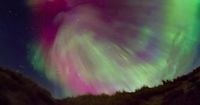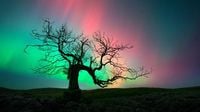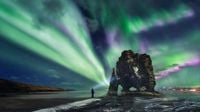On the night of April 15, 2025, the Northern Lights, also known as the aurora borealis, painted the skies across parts of the UK, captivating onlookers with their dazzling display. The phenomenon was particularly visible in Scotland, with reports flooding in from the Isle of Skye and Cumbria, where residents were treated to vibrant hues of purple and green illuminating the night sky.
The spectacle was the result of a geomagnetic storm triggered by a coronal mass ejection (CME) that struck Earth earlier that day. According to the Met Office, these solar winds travel at speeds of around one million miles per hour and can cause significant disturbances in the Earth's magnetic field. When the magnetic polarity of the solar wind is opposite to that of the Earth, it allows charged particles to flow into the planet’s magnetic poles, creating the stunning lights.
Interest in the Northern Lights has surged over the past year, as the Sun has reached the peak of its 11-year solar cycle, leading to more frequent and spectacular displays. This particular event was described by many as a once-in-a-decade occurrence, prompting avid skywatchers to grab their cameras and head outside. "I’ve never seen anything like this before," one enthusiastic observer posted on social media, while another exclaimed, "Unbelievable over Lewis, could see the huge green glow with the naked eye. One of the best shows I’ve ever seen here!"
As the geomagnetic storm continued into the night, AuroraWatch UK issued amber and red alerts, signaling heightened solar activity. The Met Office noted that while the best chances for viewing the aurora were in northern Scotland, even parts of southern England might catch a glimpse if the clouds cleared. The excitement was palpable as skywatchers hoped for another chance to see the lights on the evening of April 16.
However, the forecast indicated that cloud cover could obstruct views in many areas. The Met Office warned that while strong auroral activity was possible, visibility would depend on breaks in the clouds. "All eyes to the north tonight!" they tweeted, highlighting the potential for another light show.
The geomagnetic storm, which began at 6 PM on April 15, is expected to last until 6 PM on April 16, providing another opportunity for spectators to witness the auroras. The National Oceanic and Atmospheric Administration (NOAA) also maintained a G3 geomagnetic storm watch, indicating that while the most intense conditions might have passed, there was still a chance of minor storms continuing through the week.
Solar eruptions, including the double CME that occurred over the weekend, are responsible for these stunning displays. The eruptions release clouds of solar plasma and radiation that, when directed toward Earth, interact with the planet's magnetic field and atmosphere, resulting in the colorful lights. The CMEs that impacted Earth on April 15 were part of a series of solar events that have been closely monitored by scientists.
As the excitement builds for the next potential display, experts emphasize the significance of these solar phenomena. The auroras not only provide breathtaking visuals but also serve as reminders of the dynamic relationship between the Earth and the Sun. The Met Office explained, "Solar winds are charged particles that stream away from the Sun, and when they collide with molecules in the Earth’s upper atmosphere, they create the beautiful colors we see in the aurora borealis."
While many were fortunate enough to witness the lights on April 15, those who missed out will have to wait until 2036 for another optimal viewing period unless they are willing to travel further north. The current solar maximum means that the next 12 months will offer the best chances for aurora sightings, making this a prime time for enthusiasts and casual observers alike.
As the night draws near once again on April 16, anticipation fills the air. Will the clouds part to reveal another stunning display? Only time will tell, but for now, the Northern Lights have captured the hearts and imaginations of many across the UK.








